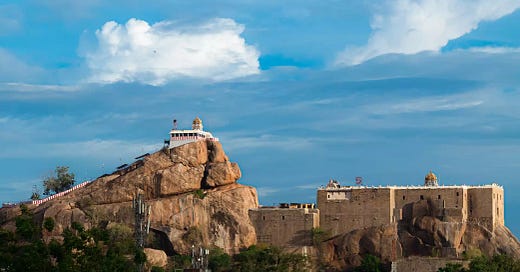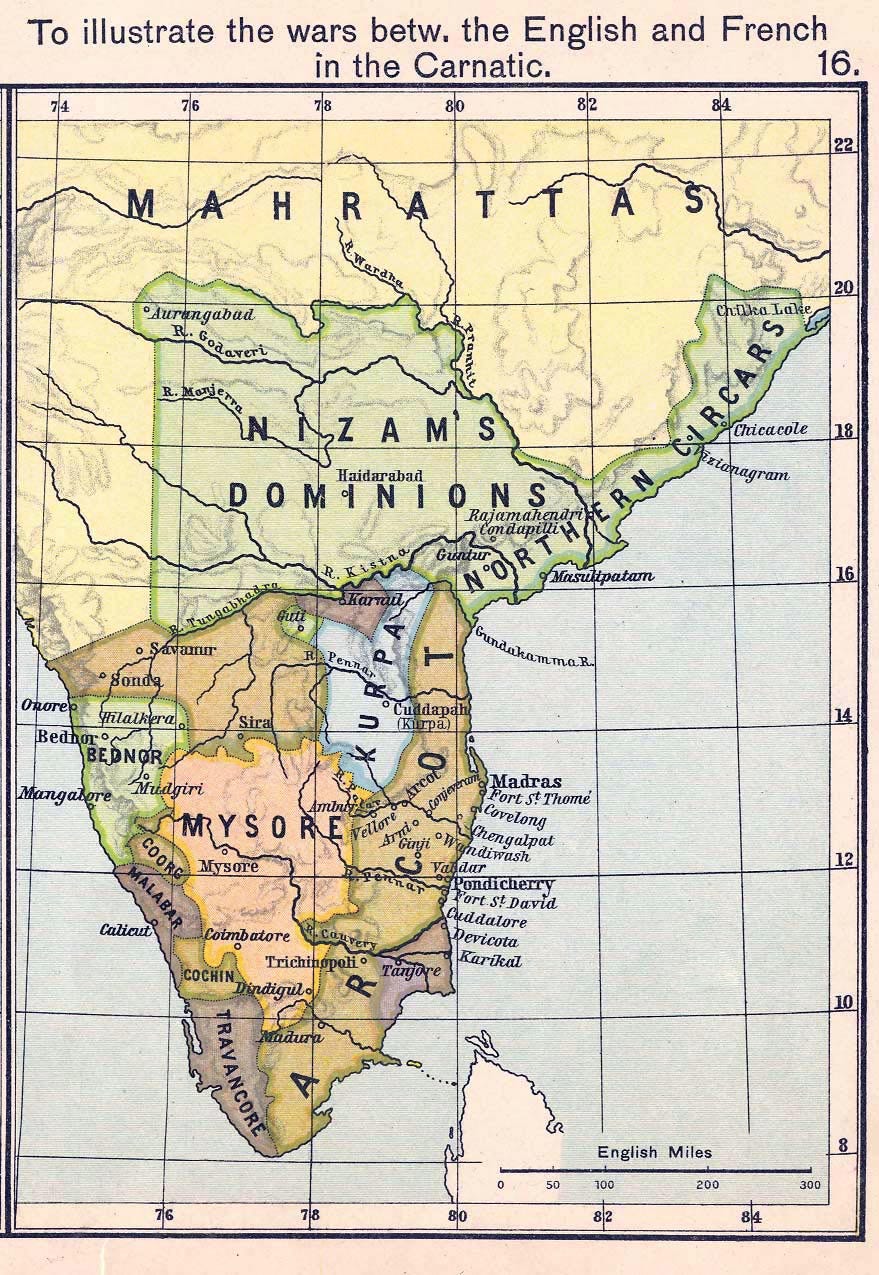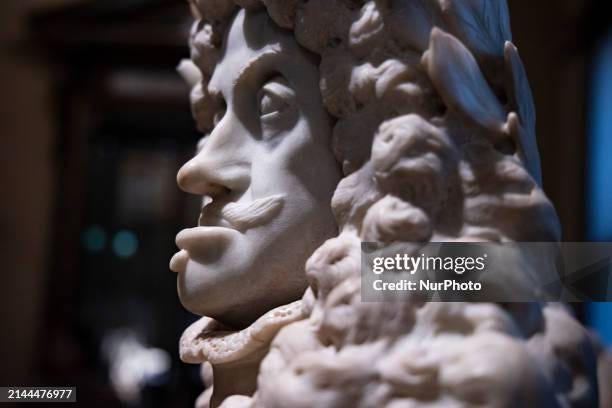Last week, we talked about the history of Mysore. Mysore was fighting the Bijapur Sultanate to keep its independence, while looking around for opportunities to expand its own territory. The Marathas are rising as well, but Mysore fights off their attempts to take them over.
Aurangzeb destroys the Bijapur Sultanate, and takes on Mysore as a vassal. He also appoints Nawabs in Kurnool, Savanur (near Hubli), Kadapa, Arcot and Sira. Plus, he appoints the Nizam at Hyderabad, to be his Viceroy of the South. In 1724, as the Mughals after Aurangzeb grew weak, the Nizam declared his independence.
At the same time, there are corrupt but able ministers, Karachuri Nanjarajayya and Dalavoy Devarajayya running Mysore, willing to commit regicide when opposed, and the king is reduced to a titular head.
This week, let’s go into developments in Mysore’s neighborhood in the 1730s and 1740s that set the stage for Haidar Ali to rise to power.
Take a nice look at that map above.
The major players here are the Marathas, Hyderabad under the Nizams, a few different players from Arcot, and the Nayaks of Thanjavur and Madurai. Let’s look at how all their fates intertwine.
Arcot-Nizam Ego Clash
So Aurangzeb installed the Nawab of Arcot, as well as the Nizam of Hyderabad.
The Carnatic kingdom, ruled from Arcot, is essentially present-day Tamil Nadu and Andhra Pradesh.
The Arcot Nawab was supposed to be under the Nizam technically, as the Nizam was the Mughal viceroy, but the Arcot Nawabs were quite the favorite in the Mughal court even after Aurangzeb, and the Nizam was quite resentful of them.
In 1710, Sadatullah Khan became the Nawab of Arcot. Despite a diet free of microplastics, pesticides and phthalates, and a presumably large harem, he had no children. He adopted his nephew Dost Ali Khan as his successor with the quiet consent of the Mughal emperor. It rubbed salt on the wounds of the Nizam to be kept out of the loop, like a middle manager caught between the Director and a 10x engineer.
This will come into play briefly. But before that, let’s see how Arcot took over Madurai and Thanjavur.
The Fall Of Madurai
Madurai was under the Nayakas, who were a principality under the Vijayanagar Empire, and, like Mysore, had declared their independence.
In 1732, King Vijayaranga Chokkanatha Nayak died. His successor was his adopted son, Vijayakumara, who was still young, so the dowager Queen Meenakshi ruled as his regent. Vijayakumara’s father, Bangaru Tirumala, felt that he deserved the throne instead, and started an uprising against the queen.
Sadatullah Khan of Arcot sent his son-in-law Chanda Sahib to adjudicate.
Chanda Sahib won the trust of Queen Meenakshi by taking an oath of alliance and friendship on a Quran. She trusted him to support her, and gave him a large amount of money to raise an army. He did and quelled Bangaru Tirumala’s revolt.
But - GASP TWIST! - Chanda Sahib hadn’t taken an oath on the Quran. It was a brick covered with a cloth!
You see, Chanda Sahib had his eyes on Tiruchi, but he couldn’t take it by force, because it was very heavily fortified. Hence he resorted to trickery.
Meenakshi came to meet him in Tiruchi, joyful at the help. But to her shock, Chanda Sahib imprisoned her. Tipu Sultan’s court historian Kirmani says that Chanda Sahib “violated her person”, which isn’t too surprising for an Islamic ruler faced with a Hindu queen. Queen Meenakshi drank poison and died in prison in 1739.
Now Tiruchi was with Arcot.
The Fall Of Thanjavur
Let’s go back to the 1670s when Bijapur was still a kingdom. There was a succession dispute after the death of the Nayak king of Thanjavur. The Sultan of Bijapur sent Ekoji to ensure their candidate won the war of succession. Ekoji, here, was the son of Shahaji, the commander of Bijapur who had invaded Bangalore and clashed with Ranadheera Kanteerava, and that made him the half-brother of Chhatrapati Shivaji.
Ekoji gets to Thanjavur, and usurps the kingdom for himself. Shivaji invaded Thanjavur, just as he had absorbed all the Hindu remnants of the Vijayanagar empire. It ended with Ekoji paying tribute to Shivaji, but once Shivaji passed, Thanjavur got back to being an independent kingdom.
In 1736, King Tukoji died and his son Shahaji III succeeded him. But Shahaji’s commander Sayyad Khan deposed him and installed Sidhoji on the throne. Now Shahaji wanted to get what was rightfully his and knocked on any door he could, including that of the French governor of Pondicherry, Benoit Dumas.
Dumas had his eye on Karaikal, and Shahaji agreed to give Dumas Karaikal if he got him back his throne. Now Sayyad Khan freaked out at this alliance, and was now very happy to get rid of Sidhoji and give back Shahaji the throne. Now Shahaji had no need for Dumas and called off the alliance.
Dumas was livid. He reached out to Chanda Sahib, and together they invaded Karaikal and took it over.
But this move worried Safdar Ali, the son of the Nawab of Arcot, and the brother-in-law of Chanda Sahib. To gain some power for himself, Safdar Ali attacked Arcot, defeated and deposed Shahaji, and installed his more pliant brother Pratapsinh on the throne.
Thus, now, Thanjavur too was under the control of Arcot.
TWIST- Marathas take Arcot, Thanjavur and Tiruchi
In 1739, Nadir Shah defeated the Mughal emperor and plundered Delhi, taking away the Peacock Throne. This means the Mughals got super weak, the Marathas were emboldened, and the Nizam and Arcot were left to fend for themselves. This book even says Nadir Shah humiliated the Nizam by making him attend court on a donkey.
The Nizam at this point was quite alarmed at the power of Arcot, so he tacitly supported the Marathas invading the Carnatic.
In 1740, Chhatrapati Shahu sent a large Maratha army to liberate Thanjavur and Madurai from Islamic rule. The forces defeated the Nawabs of Kurnool and Kadapa, and headed straight for Arcot. Arcot as we discussed is surrounded by mountains on three sides and a river on the fourth, so by the time the Marathas were pouring over the mountain passes, the Nawab of Arcot sent for Safdar Ali and Chanda Sahib to come and protect him. By the time they could send forces to Arcot, the Marathas had killed Nawab Dost Ali Khan.
This scared all the Islamic power centers in the South, and Chanda Sahib retreated to the Tiruchi fort, and Safdar Ali to Vellore. Their families fled to Pondicherry where the French happily received them as well as the tons of gold and jewellery and other treasures they brought with them.
Safdar Ali saw his chance to be recognized as the new Nawab after his father, and cut out Chanda Sahib and made secret deals with the Marathas. He agreed to pay them Rs. 10,000,000 if they made him Nawab. This deal was so secret that Chanda Sahib had no idea despite both him and Safdar Ali meeting their families in Pondicherry all the time.
Marathas took the money, installed Safdar Ali as the Nawab of Arcot, and retreated.
Chanda Sahib was livid in Tiruchi. But before he could do anything, he was surrounded by Marathas. He offered to pay them 22 Lakh pagodas (half-coins of gold) so they would leave him alone. But they wouldn’t budge. War ensued, and Chanda Sahib’s forces were defeated.
Chanda Sahib was taken prisoner by the Marathas. His ransom was set at Rs. 7.5 Lakh.
Safdar Ali breathed easy, his position as Nawab cemented.
But only for a little while. Safdar Ali was soon poisoned by his cousin, and after a circuitous turn of events, Anwaruddin, a representative of the Nizam, was installed as the Nawab of Arcot.
The Marathas were angry at this turn of events.
Mysore Wants Tiruchi
Murar Rao Ghorpade was the Maratha commander who had led the assault on Chanda Sahib. The Marathas left him to administer Tiruchi and restore the Hindu temples that had suffered under Islamic rule.
But Mysore wanted to have Tiruchi as part of its kingdom. They offered the Marathas Rs. 5,000,000 to kill Chanda Sahib and restore the Hindu kingdom in Tiruchi. But the Marathas stuck to their plans to have Ghorpade run Tiruchi.
The corrupt Dalavoy Devarajayya even offered the Nizam Rs. 10,000,000 to takke over Tiruchi, knowing full well that he’d emptied the treasury to line his own pockets and there was no money to be given.
Did Mysore Want Tiruchi for the Srirangam Temple?
Vikram Sampath says Mysore had its eye on Tiruchi due to its position in the fertile Kaveri delta. And, yeah, sure, it’s great agricultural land.
But…. if you’re ruling from Srirangapatna, where Ranganathaswamy watches over and guides your every move, and you consider all islands on the Kaveri to be dedicated to Vishnu, and the largest temple complex dedicated to Ranganathaswamy in Srirangam is now open to plunder by Islamists…. wouldn’t you consider it your God-given duty to ensure its safety with your life and limb? Wouldn’t you want to ensure safety of your people who go for the Tri-ranga darshana - you already have Adi Ranga and Madhya Ranga in your territory, wouldn’t you want to also have Antya Ranga as well?
While this is beyond the scope of this book that is on Tipu Sultan, Vikram Sampath doesn’t quite go into viewing the religious motivations of the Marathas. He does say they wanted to liberate Thanjavur and Tiruchi, both big religious centers, but doesn’t expand on it.
Offering money they didn’t have to ensure Chanda Sahib was killed is a big deal. It can’t be just a play to get access to fertile lands; there are a lot of fertile lands. It feels like a motivation of a higher order.
Mysore-Maratha Conflict!
The Nizam, despite having allowed the Marathas into the Carnatic to cut down Arcot, was now uncomfortable with their influence. In 1943, when the Maratha leaders were away in Bengal, the Nizam hit Tiruchi with a massive number of troops. Ghorpade tried to hold down the fort, but when reinforcements didn’t come for six months straight, he made a deal in 1743 to withdraw in return for Rs. 200,000 and the fort of Penukonda.
By the end of 1744, the Marathas tried to wrest back Tiruchi. But fighting them back was literally everyone in the south - the Nawabs of Kadapa, Kurnool Savanur and Sira, and the Nayaks of Ikkeri (Western Ghats and the coast around Mangalore), and, Mysore! This alliance fought back the Marathas from Tiruchi in 1745.
Haidar Ali Gets A Promotion
In 1749, the Marathas and the Nizam both supported the Chief of Doddaballapura in taking Devanahalli (Again, this is hilarious now because there’s a bus every 20 minutes between Devanahalli and Doddaballapur).
Obviously, Mysore couldn’t take this upstart behavior, especially if it involved its rivals funding rebellions in its borders, and sent troops to quell this.
Haidar Ali debuted as a horseman here. The troops sieged Devanahalli for nine months, before storming the fort and taking the upstart chief Range Gowda prisoner.
This was an important battle for Mysore, so our good old Dagger Dave, Karachuri Nanjarajayya, paid attention to this win. It turned out that this young soldier was cool and confident under danger, and his heroics were instrumental in the win. Like an Amazon Door Desk Award to a new intern, Haidar Ali now got to command 50 horse and 250 foot soldiers, and was put in charge of the gates at a frontier fortress.
If you think all of the chaos we’ve covered so far were chaotic, hold your horses (and foot soldiers), Europe was having some drama of its own, which would change the course of history in India.
Interlude: What On Earth?!
I find a few things rather intriguing - On the one hand, both the Marathas and Mysore recognized the importance of controlling the Hindu holy sites. But at the same time, they didn’t mind allying with the Nizam or Arcot or installing puppet Nawabs towards this aim.
I understand why there’s the popular image of “In India everyone was fighting with everyone” type of attitude, and “We called them to adjudicate our internal conflict and the British came and usurped our country”. As we see, wars of succession were common, and even though there was always the danger of usurpation, that didn’t stop successive generations of claimants from taking the help of outsiders to get to the throne.
What I still lack clarity on is how did these kings see each other? What exactly did they think was at stake when they warred? Why were Mysore and the Marathas at odds with each other? How did they see the Europeans? Mind, at this time the Portuguese were already ruling Goa for 200+ years, so they should have had some idea.
War over the Holy Roman Empire and the Habsburgs.
We mostly know the Habsburgs for their inbreeding, which led to this masterpiece of a jaw
But that’s not all they did. The Habsburg lineage controlled vast amounts of land in Europe. Due to that, they were elected to be the Emperor of the Holy Roman Empire for 300 years in a row.
This Holy Roman Empire at this point was roughly Austria, and it didn’t contain Rome - Rome was part of the ‘Papal States’. But they kept the name as they saw the position as the successor state to Ancient Rome. And, the Habsburgs saw themselves as the defenders of the Catholic faith. They also secured alliances across empires and states through marriage. So they won all the elections to be the Holy Roman Emperor.
In 1740, the male line of the Habsburgs had died out. Emperor Charles VI wanted to ensure his daughter Marie-Therese would inherit his vast lands. Women couldn’t inherit, but the Emperor had worked to obtain a Pragmatic Sanction for his daughter to inherit his land, and countries across Europe had agreed to it.
But what caused conflict was that France said a woman couldn’t be Holy Roman Emperor.
Of course, this was just a pretext. The Bourbon dynasty of France had always been rivals to the Habsburgs, and they were sick of the status quo and wanted to use this opportunity to gain more power.
But if France got powerful, that would mess up Britain’s interests in Continental Europe, and so Britain was heavily invested in the status quo.
So Britain supported Marie Therese, and France opposed her. This led to a bitter War of Succession where countries all lined up on different sides of the conflict, hoping that chaos was a ladder.
European Conflict Comes To India - The First Carnatic War
Now despite France and Britain fighting bitterly in Europe, the French and British East India Companies were quite friendly.
But that swiftly came to an end in 1746.
As if the conflicts in the Carnatic weren’t enough already, a naval squadron came from France, with troops, and attacked Madras, the main British settlement in India. Fort St. George in Madras wasn’t a strong fortress and fell in six days. The French had also promised to the Nawab of Arcot, Anwaruddin, that they would give him Fort St. George.
Due to internal conflicts, the French reneged on this. Now the Nizam of Hyderabad and Nawab of Arcot were angry with the French. When the French then tried to take Fort St. David in Cuddalore, the Arcot forces joined hands with the British to successfully quell the French by the end of 1746.
Then a British naval fleet arrived in 1748 and sieged Pondicherry. But Pondicherry was strongly fortified, and the British-Arcot forces didn’t make much headway. The Austrian War of Succession ended in October 1748, which brought an end to the British-French conflict in India as well, and one of the terms was for the French to return Madras to Britain.
Both the British and French were now deeply entangled in Indian politics.
France for its part had been negotiating with the Marathas to release Chanda Sahib to them. The Marathas had set a ransom of Rs. 750,000 for Chanda Sahib. The French negotiated it down to Rs. 300,000. Plus, while the Marathas were asking the French to hand over Chanda Sahib’s family to them, the French plied the Maratha commander with French wine, which he was enamoured by enough to let go of this claim.
In 1748, Chanda Sahib was set free on the condition that Hindu rule in Tiruchi and Thanjavur were not to be interrupted.
He was now without a crown, and available to the French.
The next century promised to be interesting.






